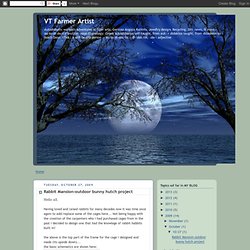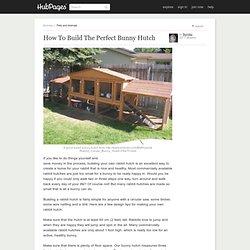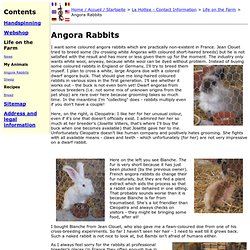

English Angora Rainbow of Colors. *Bumblebee Acres* English Angora Rabbit Colors of the Rainbow Coat Color transitions of English Angora Bunnies from baby (kits) to adults (seniors).

Some colors are missing at this point either the adult or the baby comparisions, we will be adding on to this page continuely. In our breeding program. (in basket above are; a lynx, 2 chestnut agoutis, a black, and REWs) White Classification SELF Group: Ruby eyed whites (REW) Description: Color pure white. The white wool is a wonderful choice for those considering a bunny for spinning as it can be dyed a multitude of colors. Blue eyed whites (BEW) Description: Color is pure white with blue eyes. Lilac Pointed Description: Body is pure white with Lilac color on ears, feet, nose, and tail.
Eyes pink. Colored Classification Self Group: Black Description: Guard hairs and furred areas are deep black. Wool is dark slate, but may fade somewhat towards the skin. Blue In the basket are 2 REWs, 2 Blue, and 1 Black kit. Wool is lighter blue. Chocolate Lilac. Rabbit Mansion-outdoor bunny hutch project. Hello all.

Having loved and raised rabbits for many decades now it was time once again to add/replace some of the cages here... Not being happy with the creation of the carpenters who i had purchased cages from in the past i decided to design one that had the knowlege of rabbit habbits built in! The above is the top part of the frame for the cage i designed and made (its upside down)...the basic schematics are shown here: Cage lenth is 8 foot with a solid divider at 48". this seperates the cage into two seperate living areas. each 48 " area has at the outside end a 12" area that has a partial divider leading to the main area (36" area) via a large "mouse hole". the 12" w has wood walls and a wood door this area is for the mothers to have their babies (nest area).
The 36" w area has a fan gal welded wire front (1x2) with a wire door complete with edge guards. water bottles and food hoppers hang on the wire area, as do the hay racks and cage cards. Lol.... Rabbit Hutches, Rabbit Runs and Rabbit Cages. How To Build The Perfect Bunny Hutch. If you like to do things yourself and save money in the process, building your own rabbit hutch is an excellent way to create a home for your rabbit that is nice and healthy.

Most commercially available rabbit hutches are just too small for a bunny to be really happy in. Would you be happy if you could only walk two or three steps one way, turn around and walk back every day of your life? Of course not! But many rabbit hutches are made so small that is all a bunny can do. Building a rabbit hutch is fairly simple for anyone with a circular saw, some timber, some wire netting and a drill.
Make sure that the hutch is at least 60 cm (2 feet) tall. Make sure that there is plenty of floor space. Design your hutch with a large lid for easy access. Make sure that you provide shelter in the hutch. Chosing the wire gauge is another decision you will have to make. How to Build a Rabbit Condo. Angora Rabbits. I want some coloured angora rabbits which are practically non-existent in France.

Jean Clouet tried to breed some (by crossing white Angoras with coloured short-haired breeds) but he is not satisfied with the result and has more or less given them up for the moment. The industry only wants white wool, anyway, because white wool can be dyed without problem. Instead of buying some coloured rabbits in England or Germany, I'll try to breed them myself. I plan to cross a white, large Angora doe with a colored dwarf angora buck. That should give me long-haired coloured rabbits in various sizes in the first generation. Here, on the right, is Cleopatra: I like her for her unusual colour, even if it's one that doesn't officially exist.
Here on the left you see Blanche. I bought Blanche from Jean Clouet, who also gave me a fawn-coloured doe from one of his cross-breeding experiments. And when the weather is good (Angora rabbits are not "waterproof") they go outside. D. Lee Woolee's Rabbitry and Yarns.